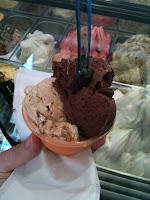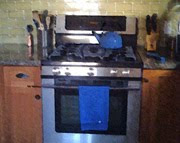I recall my Italian cooking class in Venice almost like part of a dream. It wasn't so long ago, yet already seems quite distant with weeks of work and normal life separating me from the adventure that was Italy. I took some notes only to later misplace them (I know they are in my apartment somewhere, and yet no amount of looking in likely places has revealed them; certainly I'll come upon the folded piece of paper shortly after I publish this post). Which means I must put my faith in my memory (a scary thing) and photographs to attempt to recreate the magical evening in words for you now.
After walking through the narrow streets and across the many canals of Venice, I arrived in the evening to a modern loft and an amazing spread: italian meats and cheeses, a wonderfully salty roe spread and crisp pane to enjoy it on, freshly baked frittata. This was enjoyed while beginning to learn about the art of wine pairing. The "class" was one other person (a friendly fellow foodie originally from the midwestern US) plus myself, the sommelier, and Enrica, our lively instructor.
The evening was less filled with the labor of cooking than I had anticipated, with much more emphasis on the enjoyment of eating and drinking than on the preparation of food itself. Still, I learned some valuable food lessons along the way.
There were two dishes we were to make to accompany the food that Enrica had already prepared: risi e bisi (literally rice and peas; our version was a fresh spring pea risotto) and chicken cacciatore. The latter involved cutting up a whole chicken, which sounded overly ambitious for someone who spent a decade as a vegetarian and rarely cooks meat, so I settled on the tamer adventure of risotto. Yes, I've made risotto before. But there had to be some tricks to learn from an Italian, right? There were.
First lesson: NEVER (ever, ever, ever!) use arborio rice. Never! This is what I was told by Enrica. I found this odd, as every recipe I've ever seen for risotto specifies arborio rice. When I asked why, she reiterated that NEVER should you use arborio for risotto, you should use carnaroli. I still need to seek this out in the states. I'm not sure I could have identified the difference in the resulting risotto. Which makes me think that a side by side taste test may be in order...
The second lesson, I learned from the sommelier, as I was absentmindedly stirring the risotto while watching my cooking mate hack up the chicken. ONLY STIR CLOCKWISE! Again, questions as to why were met with only reiteration of the point. So I'm not sure why, but it was said with such vigor that I will certainly never stir risotto in a counterclockwise direction again.
Here is the pictorial progression from fresh spring peas to risi e bisi:


The actual preparation of the risi e bisi was similar to risottos I've made before (with exception of the lessons learned above). It started with thinly sliced onion in a dutch oven in equal amounts olive oil and butter. Once they've softened, add a cup of rice and stir until it has a nice sheen. Add about a half cup white wine, followed by hot chicken stock (we used freshly made, which really does bring a whole new dimension to the dish vs. purchased stock), 1 ladle at a time, stirring constantly (only clockwise!), adding more stock each time it has been fully absorbed in the rice (for a total of about 4 cups of stock). We added our peas at the beginning of the cooking process; I'd recommend adding them later so they aren't mushy by the end (I tested this out with fresh peas in my favorite risotto a couple weeks ago - adding them with the penultimate broth ladle yielded peas that were cooked but still had some resistance when bitten into, which I prefer). Finish the risotto with about a quarter cup grated parmesan and a slab of butter. Toothsome heaven in a bowl.
 My partner did an incredible job on the chicken cacciatore. I'm not generally a big poultry fan, but the bright flavors in this dish seemed to be made to go together: salty, sweet, tangy tomato-chicken loveliness. From memory, it included onions, red (and possibly orange or yellow?) bell pepper, olives, tomatoes, and of course chicken. It all simmered together for a long time. We enjoyed it with cous cous.
My partner did an incredible job on the chicken cacciatore. I'm not generally a big poultry fan, but the bright flavors in this dish seemed to be made to go together: salty, sweet, tangy tomato-chicken loveliness. From memory, it included onions, red (and possibly orange or yellow?) bell pepper, olives, tomatoes, and of course chicken. It all simmered together for a long time. We enjoyed it with cous cous. We also had an asian-inspired orange-soy duck dish that Enrica prepared. Desert was comprised of Italian esse cookies (stay tuned for more on these: I've since recreated something similar in my California kitch) dipped in Prosecco (can it get any more italian than that?).
Enrica was highly entertaining. Italian born and raised, she has worked in and owned restaurants around the world and currently travels between London and Venice conducting private cooking lessons (learn more at www.enricarocca.com). Her loft, where the Venice cooking classes are held, is an amazing and modern entertaining space. The focus is definitely on the kitchen, where the abundant appliances (two dishwashers!) are all clean lines and stainless steel. The center of the kitchen is a giant island with embedded range and the deepest sink and largest faucet I've ever seen. Barstools along one side provided front row seats to watch the kitchen action in between the direct participation. Enrica has an obvious passion for food and life, which she brings to her every motion. If you ever have the opportunity, I'd highly recommend cooking with her. I hope to get to again at some point.
A word on wine before I close... Our sommelier was the owner of a local wine shop who taught us about the uniqueness of each beautiful Italian wine and what made it pair perfectly with the various courses of our meal. We learned about balancing the acidity, spiciness, and fattiness of the food in equal measure with these tastes in the wine. We taste-tested to detect when the wine was too much for the food in any of these dimensions and vice versa. If I could locate my notes, I'd have a list of the actual wines, but alas, it is lost. The wines and the evening will just have to be a distant, magical memory. It's one I will revel in for much time to come... until my next Italian adventure, at least.
Enrica extended an invitation for the following morning to join her and another class at the Rialto Market, an open air market in Venice that is particularly known for its seafood. This was an opportunity not to miss. Words can't do it justice, but I've included some pics below. The market operates Tuesday through Saturday mornings and is an absolute must-see if you ever find yourself on the wonderful island of Venetia. Bellissimo!

































